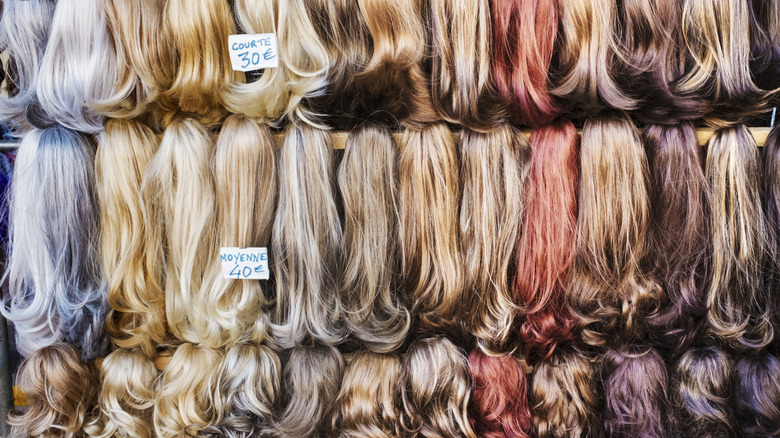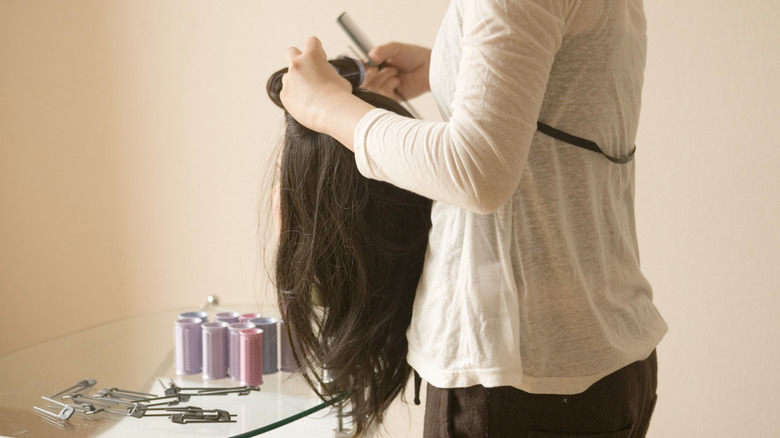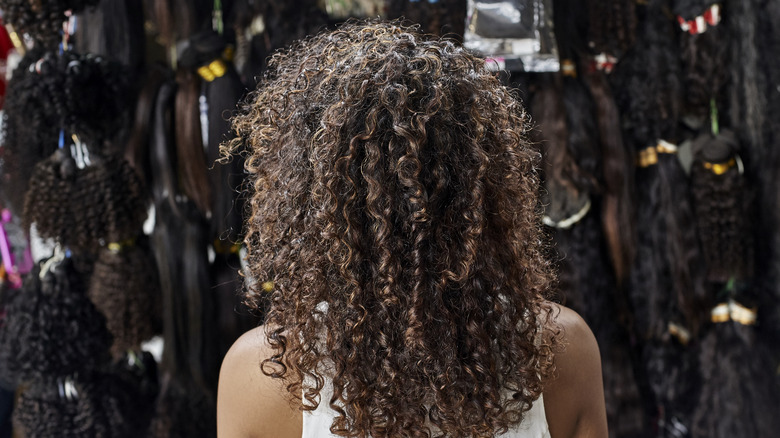Where Does The Real Human Hair Used In Extensions And Wigs Come From?
With hair trends evolving at the speed of light, it can be challenging for your tresses to keep up. After all, changing your style can be a big commitment. But for anyone wanting to try hairstyles like the popular wavy blunt bob without pigeonholing yourself, wigs offer a perfect solution. Enjoy a different hairdo from one day to the next — especially with human-hair wigs, which rule the roost with their adaptability.
Glam spoke exclusively with Jennifer Korab, hairstylist and owner of Renaissance Salon, to learn more about the potential of human hair wigs. "The rising popularity of human hair wigs and extensions ... stems from their natural appearance, versatility, and durability," Korab explains, adding that real hair offers "a seamless and authentic look that synthetic alternatives often can't match." In particular, Korab praises human hair options because they allow for "diverse styling, coloring, and customization." Unlike many synthetic options, real-hair wigs and extensions hold up to heat styling — and you can even dye your wig at home if you know how to do it right.
However, real-hair pieces are often pricier than synthetic wigs, which can be wholly manufactured. After all, natural human hair requires a whole process of gathering and processing before it becomes available to beauty fans in wig form. It begs the question: Where does all that human hair come from?
Asian hair is particularly popular in human hair wigs
Korab explains that the human hair used in wigs and extensions is mainly sourced from regions like India, China, Eastern Europe, South America, and Southeast Asia. This is backed up by data from Statista, which reports that India was by far the number one human hair exporter in 2022 — selling hair in amounts worth nearly $140 million. "In India, it's often collected from temple rituals where devotees shave their heads," Korab tells Glam.
Statista said 2022's next biggest exporters were Pakistan, Singapore, Indonesia, and Brazil. "South American and Southeast Asian hair is valued for its texture and quality," says Korab. But people in other regions can also get in on the human-hair market — as Korab notes, "In Eastern Europe, women sometimes sell their hair directly."
For anyone who's ever watched "Les Misérables," the idea of selling your hair might feel tied to human misery and an undefinable ick factor. But today's real-hair industry has come a long way from its roots — pun intended. "There is a growing emphasis on ethical sourcing," Korab shares, explaining that some companies are working to prioritize fair compensation and transparency to protect hair contributors.
Some charitable organizations also create wigs from donated hair, often for cancer patients and others facing hair loss. But if you're planning to chop off your own locks for charity, do some research first — there are a few things you should know before donating your hair.
There are real-hair options for many budgets
Wondering if you can afford the style and quality of human hair? Happily, there are options available at many different price points. "Start by determining your exact needs — whether you're looking for something for everyday wear, special occasions, or a versatile piece for styling," Korab recommends. "Consider matching the wig or extensions to your natural hair type and texture to ensure a seamless blend." If it falls within your budget, she also suggests prioritizing "Remy" hair, which aligns hair cuticles in the same direction to fall naturally and prevent tangling.
Korab lists a few favorite brands for human-hair pieces, including Bellami, Hairdreams, Luxy Hair, and RPGShow. For the VIP experience, Korab also notes that custom wig makers can tailor products to your specific vision and needs — but this service will come with a premium price tag.
"For wigs, expect to pay anywhere from $300 to $1,500+ depending on factors like length, density, and customization, with premium, custom-made wigs ranging from $1,000 to $3,000 or more," Korab warns. "Extensions, such as clip-ins or tape-ins, typically cost between $100 and $500, while high-quality hand-tied or sewn-in wefts can range from $300 to $2,000." This can mean a significant up-front expense. However, whereas a synthetic wig may survive 6 months of regular use, a well-maintained human hair wig can last up to 5 years. In other words, human hair is a potential game-changer for both your look and the wig's lifespan.


